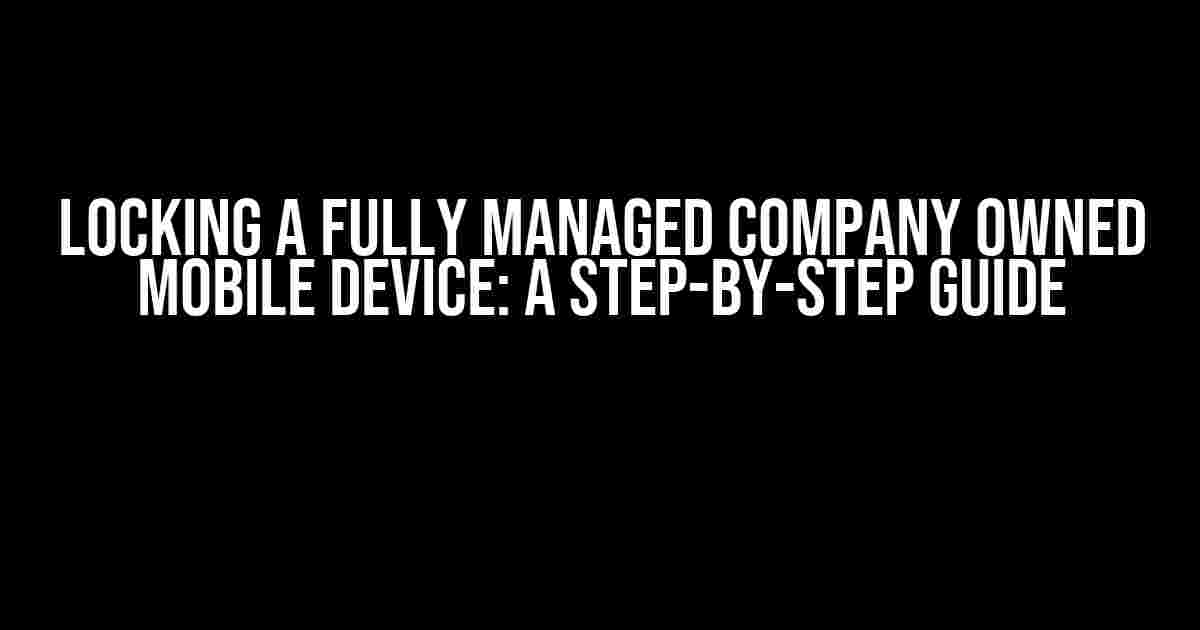As an IT administrator, one of your top priorities is to ensure the security and integrity of company-owned mobile devices. With the increasing number of devices used in the workplace, it’s essential to have a comprehensive mobile device management (MDM) strategy in place. Locking a fully managed company-owned mobile device is a crucial aspect of this strategy, and in this article, we’ll provide a step-by-step guide on how to do it effectively.
Why Lock a Fully Managed Company-Owned Mobile Device?
Before we dive into the process, let’s understand why locking a fully managed company-owned mobile device is necessary. Here are some compelling reasons:
- Security: Locking a device ensures that only authorized personnel can access company data, preventing unauthorized access and potential data breaches.
- Compliance: Many industries require companies to maintain the confidentiality of sensitive data, and locking devices helps meet these compliance regulations.
- Data Protection: By locking a device, you can remotely wipe or lock it in case it’s lost or stolen, protecting company data from falling into the wrong hands.
- Productivity: Locking a device can help reduce distractions and minimize personal use during work hours, increasing employee productivity.
Preparation is Key
Before locking a fully managed company-owned mobile device, make sure you have the following in place:
- MDM Solution: Choose a reputable MDM solution that supports your device management needs. Popular options include Microsoft Intune, MobileIron, and VMware Workspace ONE.
- Device Enrollment: Ensure that the device is enrolled in the MDM solution, and the necessary policies are configured.
- Password Policy: Establish a strong password policy that meets your company’s security requirements.
- User Awareness: Educate employees on the importance of device security and the consequences of non-compliance.
Locking a Fully Managed Company-Owned Mobile Device
Now that you have everything in place, let’s walk through the step-by-step process of locking a fully managed company-owned mobile device:
Method 1: Remotely Locking a Device using MDM
Using your MDM solution, follow these steps to remotely lock a device:
1. Log in to your MDM console and navigate to the device list.
2. Select the device you want to lock and click on "Device Actions" or "Remote Lock".
3. Confirm the action by clicking "Lock" or "Remote Lock" again.
4. The device will receive the lock command and will be locked immediately.
Method 2: Locking a Device using Exchange ActiveSync (EAS)
If you’re using Exchange ActiveSync (EAS) to manage your company’s email, you can lock a device using the following steps:
1. Log in to the Exchange Admin Center (EAC) and navigate to the "-recipients" section.
2. Select the device you want to lock and click on "Edit".
3. Scroll down to the "Mobile Device" section and click on "Edit".
4. Select "Remote Lock" and click "Save".
5. The device will receive the lock command and will be locked immediately.
Device Locking Best Practices
To ensure effective device locking, follow these best practices:
| Practice | Description |
|---|---|
| Use Strong Passwords | Require employees to use strong, unique passwords for device unlock. |
| Enable Two-Factor Authentication | Implement two-factor authentication to add an extra layer of security. |
| Set Up Device Lockout Policies | Configure device lockout policies to lock devices after a specified number of incorrect password attempts. |
| Regularly Review Device Compliance | Monitor device compliance regularly to ensure that devices are up-to-date and meeting security requirements. |
Conclusion
Locking a fully managed company-owned mobile device is a crucial aspect of mobile device management. By following the steps outlined in this article and implementing best practices, you can ensure the security and integrity of company data. Remember to stay vigilant and continually monitor device compliance to prevent potential security breaches.
By locking devices, you’re not only protecting company data but also promoting a culture of security and responsibility within your organization. With the right tools and strategies in place, you can strike a balance between security and employee productivity, ultimately leading to a more secure and efficient work environment.
Frequently Asked Question
Got questions about locking a fully managed company-owned mobile device? We’ve got answers!
What happens when I lock my company-owned mobile device?
When you lock your company-owned mobile device, you’re essentially shutting down access to the device and all its contents. This means that anyone trying to use the device won’t be able to access company data, apps, or settings without the correct PIN, password, or fingerprint authentication.
Can I still receive calls and messages when my device is locked?
Yes, you can still receive calls and messages even when your device is locked. The lock feature only restricts access to the device’s home screen and apps, but it won’t affect your ability to receive incoming calls, texts, or emails.
Will locking my device erase all my personal data?
No, locking your device won’t erase any personal data. The lock feature is designed to secure the device and its contents, not delete them. Your personal data, such as contacts, photos, and apps, will remain intact and accessible once you unlock the device.
Can I lock my device remotely if it’s lost or stolen?
Yes, you can lock your device remotely using various mobile device management (MDM) tools or platforms. This feature allows you to secure your device and its contents even when you’re not physically near it, giving you peace of mind in case your device is lost, stolen, or compromised.
How do I unlock my device if I forget my PIN or password?
Don’t worry, it happens to the best of us! If you forget your PIN or password, you can try to reset it using the device’s built-in reset options or by contacting your company’s IT department for assistance. They may be able to help you regain access to your device or guide you through the reset process.

